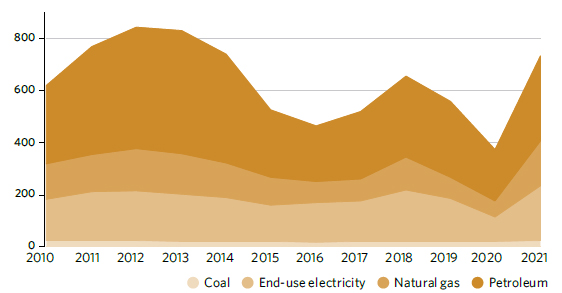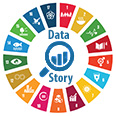Responsible consumption and production

Workers sort plastics at a recycling plant in Côte d’Ivoire. Plastic pollution threatens the countries’ coast, lagoons, fishing and tourism. Overhauling the economic model governing plastics is essential to address this crisis.
© UNEP/Ollivier Girardpolicies that support a shift towards sustainable practices and decouple economic growth from resource use.
Regional inequalities in material footprints highlight consumption disparities
Between 2000 and 2019, global domestic material consumption– the amount of raw materials directly used for production processes in a country – increased by 66 per cent, tripling since the 1970s to reach 95.1 billion metric tons. In 2019, the corresponding material footprint – the amount of materials extracted to satisfy final consumption demand in a country – was 95.9 billion metric tons. While the total volumes are similar globally, comparisons reveal regional inequalities in the environmental impact. In Northern Africa and Western Asia, and in Europe and Northern America, the material footprint in 2019 exceeded domestic material consumption by 18 per cent and 14 per cent, respectively, while in Latin America and the Caribbean and sub-Saharan Africa, the material footprint was lower than domestic material consumption by 17 per cent and 32 per cent, respectively. These differences highlight the unequal responsibilities and consumption disparities between import-oriented and export-oriented and generally high-income and low-income countries. The material footprint per capita in high-income countries is 10 times the level of low-income countries. Therefore, it is essential to adopt sustainable policies and raise awareness to ensure efficient and sustainable management of limited and unequally exploited natural resources by 2030.
Excess of domestic material consumption over material footprint, 2019 (percentage)

Fossil fuel subsidies rise back to 2014 levels despite calls for a phase-out
Fossil-fuel subsidies create distortions in energy markets, hinder the transition to cleaner and more sustainable alternatives, and undermine efforts to combat climate change. In 2021, global data showed a resurgence of such subsidies, with governments spending an estimated $732 billion on subsidies for coal, oil and gas, nearly doubling the $375 billion spent in 2020. This was largely attributed to a rebound in energy prices after a drop in 2020, bringing subsidies back to 2014 levels. Unfortunately, the global energy crisis triggered by Russia’s invasion of Ukraine in 2022 is likely to cause another increase in fossil fuel subsidies. Hopefully, these will be short-term measures aimed at protecting consumers from the impacts of the crisis. Many governments are now taking steps towards longer-term solutions. Some are seeking to increase or diversify oil and gas supplies, while others are accelerating structural changes.
Global estimates of fossil fuel subsidies, by fuel type, 2010–2021 (billions of dollars, nominal value)

Despite rising global hunger, food waste and losses are staggering and uneven
In 2021, although 828 million people were facing hunger, 13.2 per cent of the world’s food was lost after harvest along the supply chain from farm to consumer, hardly changed since 2016 and falling short of the target of substantially reducing post-harvest food losses by 2030. An additional 17 per cent of food is wasted at household, food service, and retail levels, resulting in a staggering 931 million tons of food waste or 120 kilograms per capita in 2019. Sub-Saharan Africa experiences the highest food loss, at 20 per cent, compared with 9 per cent in Europe and Northern America. While food loss shows regional differences, especially between high and low-income regions, household food waste per capita is similar across all regional groups, highlighting the need for action in all countries. Despite the importance of reducing food loss and waste, data are still scarce. Tackling food loss and waste is urgent and requires dedicated policies, informed by data, as well as investments in technologies, infrastructure, education and monitoring.
Estimated total food waste and food waste in households per person, 2019 (kilograms)

*Excluding Australia and New Zealand.
More companies, large and small, are reporting on their efforts to improve sustainability
The trend towards sustainability reporting is on the rise, with around 70 per cent of monitored companies publishing sustainability reports in 2021 – triple the percentage since 2016. South-Eastern Asia and Central America have experienced the highest increase in sustainability reporting between 2020 and 2021, while the highest volume of reports is seen in Eastern Asia, Europe and Northern America. While large companies continue to lead the way in sustainability reporting, there is evidence of growth in disclosures among small and medium-sized enterprises, with growth rates of 37 and 34 per cent, respectively, between 2020 and 2021. Companies are most likely to disclose policies related to water and energy, CO2 emissions, occupational health and safety, and board diversity. Companies continue to detail their activities in attaining the Sustainable Development Goals, but only 10 per cent report on all 17 Goals. Overall, the trend towards better sustainability reporting is a positive development, indicating a growing awareness of the need to prioritize sustainable practices across all industries.
Increase in companies publishing sustainability reports, between 2020 and 2021 (percentage)

*Excluding Australia and New Zealand.
Global cooperation on sustainable consumption and production rises, while reporting dwindles
Multilateral and multi-stakeholder cooperation on sustainable consumption has increased since 2015, inspiring science-based and transformative policies in numerous countries. Between 2019 and 2022, 485 policy instruments supporting the shift to sustainable consumption and production were reported by 62 countries and the European Union, with increasing linkages to global environmental commitments on climate, biodiversity, pollution, waste and high-impact sectors. Meanwhile, reporting has been decreasing by an average of 30 per cent every year since 2019, and continues to reflect great regional imbalances, with more than 50 per cent of policy instruments reported from Europe and Central Asia. Nevertheless, the international community adopted three ambitious agreements in 2022, including the Sharm el-Sheikh Implementation Plan for a new global climate pact, the Kunming-Montreal Global Biodiversity Framework, and the United Nations Environment Assembly resolution 5/14 on ending plastic pollution. These agreements underscore the need to shift towards a more sustainable and circular approach to consumption and production.
Despite increased public procurement reporting, sustainable tourism monitoring is down
Public procurement is a key factor in the economy of all countries, representing on average 13–20 per cent of GDP. Governments can leverage their purchasing power to drive markets towards greener and more innovative products and services, supporting sustainable development. In 2022, 67 national governments reported to the United Nations Environment Programme on the implementation of sustainable public procurement policies and action plans, a 50 per cent increase from 2020. However, data show a marked decline in the number of countries implementing tools to monitor the sustainable development impacts of tourism in 2020–2021, mainly due to disrupted statistical operations during the COVID-19 pandemic. While tourism contributes to creating jobs and promoting local culture and products, sustainable management of the sector’s development is essential to protect its value. Countries must prioritize monitoring sustainable tourism practices as part of their recovery, ensuring economically viable and environmentally sustainable tourism.


